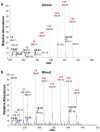Direct and quantitative analysis of underivatized acylcarnitines in serum and whole blood using paper spray mass spectrometry
- PMID: 22760507
- PMCID: PMC3598621
- DOI: 10.1007/s00216-012-6211-4
Direct and quantitative analysis of underivatized acylcarnitines in serum and whole blood using paper spray mass spectrometry
Abstract
A simple protocol for rapid quantitation of acylcarnitines in serum and whole blood has been developed using paper spray mass spectrometry. Dried serum and whole blood containing a mixture of ten acylcarnitines at various concentrations were analyzed as spots from paper directly without any sample pretreatment, separation, or derivatization. The composition of the spray solvent was found to be a critical factor: for serum samples, spray solvent of methanol/water/formic acid (80:20:0.1) gave the best signal intensity while for blood samples which contain more matrix components, acetonitrile/water (90:10) was a much more suitable spray solvent. For the paper type and size used, 0.5 μL of sample provided an optimal signal for both serum and whole blood samples. For quantitative profiling, the limits of quantitation obtained from both serum and blood were much lower than the clinically validated cutoff values for diagnosis of fatty acid oxidation disorders in newborn screening. Linearity (R(2) > 0.95) and reproducibility (RSD ~10 %) were achieved in the concentration ranges from 100 nM to 5 μM for the C2 acylcarnitine, and for other acylcarnitines, these values were from 10 to 500 nM. Acylcarnitine profiles offer an effective demonstration of the fact that paper spray mass spectrometry is an appropriate, simple, rapid method with high sensitivity and high reproducibility applicable to newborn screening tests.
Figures





Similar articles
-
A rapid UPLC-MS/MS method for simultaneous separation of 48 acylcarnitines in dried blood spots and plasma useful as a second-tier test for expanded newborn screening.Anal Bioanal Chem. 2012 Aug;404(3):741-51. doi: 10.1007/s00216-012-6194-1. Epub 2012 Jul 6. Anal Bioanal Chem. 2012. PMID: 22766757
-
A quantitative method for acylcarnitines and amino acids using high resolution chromatography and tandem mass spectrometry in newborn screening dried blood spot analysis.J Chromatogr B Analyt Technol Biomed Life Sci. 2012 Aug 15;903:142-9. doi: 10.1016/j.jchromb.2012.07.008. Epub 2012 Jul 20. J Chromatogr B Analyt Technol Biomed Life Sci. 2012. PMID: 22846691
-
Differences between acylcarnitine profiles in plasma and bloodspots.Mol Genet Metab. 2013 Sep-Oct;110(1-2):116-21. doi: 10.1016/j.ymgme.2013.04.008. Epub 2013 Apr 13. Mol Genet Metab. 2013. PMID: 23639448
-
Use of tandem mass spectrometry for multianalyte screening of dried blood specimens from newborns.Clin Chem. 2003 Nov;49(11):1797-817. doi: 10.1373/clinchem.2003.022178. Clin Chem. 2003. PMID: 14578311 Review.
-
The use of mass spectrometry to analyze dried blood spots.Mass Spectrom Rev. 2016 May-Jun;35(3):361-438. doi: 10.1002/mas.21441. Epub 2014 Sep 22. Mass Spectrom Rev. 2016. PMID: 25252132 Review.
Cited by
-
Simultaneous quantitation of five triazole anti-fungal agents by paper spray-mass spectrometry.Clin Chem Lab Med. 2020 Apr 28;58(5):836-846. doi: 10.1515/cclm-2019-0895. Clin Chem Lab Med. 2020. PMID: 31926066 Free PMC article.
-
Direct Mass Spectrometry Analysis of Untreated Samples of Ultralow Amounts Using Extraction Nano-Electrospray.Anal Methods. 2013 Dec 7;5(23):10.1039/C3AY41149D. doi: 10.1039/C3AY41149D. Anal Methods. 2013. PMID: 24312137 Free PMC article.
-
Studying reaction intermediates formed at graphenic surfaces.J Am Soc Mass Spectrom. 2014 Mar;25(3):380-7. doi: 10.1007/s13361-013-0786-7. Epub 2014 Jan 3. J Am Soc Mass Spectrom. 2014. PMID: 24385398
-
Ambient Ionization Mass Spectrometry Measurement of Aminotransferase Activity.J Am Soc Mass Spectrom. 2017 Jun;28(6):1175-1181. doi: 10.1007/s13361-016-1591-x. Epub 2017 Jan 31. J Am Soc Mass Spectrom. 2017. PMID: 28144898
-
Development of miniature mass spectrometry systems for bioanalysis outside the conventional laboratories.Bioanalysis. 2014 Jun;6(11):1497-508. doi: 10.4155/bio.14.100. Bioanalysis. 2014. PMID: 25046050 Free PMC article.
References
-
- Guthrie R, Susi A. A simple phenylalanine method for detecting phenylketonuria in large populations of newborn infants. Pediatrics. 1963;32(3):338–343. - PubMed
-
- Kaye CI, Schaefer GB, Bull MJ, Enns GM, Gruen JR, Hersh JH, Mendelsohn NJ, Saal HM, Goldberg JD, Hanson JW, et al. Introduction to the newborn screening fact sheets. Pediatrics. 2006;118 (3):1304–1312. - PubMed
-
- Sweetman L. Newborn screening by tandem mass spectrometry (MS-MS) Clin Chem. 1996;42(3):345–346. - PubMed
-
- Lindner M, Hoffmann GF, Matern D. Newborn screening for disorders of fatty-acid oxidation: experience and recommendations from an expert meeting. J Inherit Metab Dis. 2010;33(5):521–526. - PubMed
Publication types
MeSH terms
Substances
Grants and funding
LinkOut - more resources
Full Text Sources
Miscellaneous

